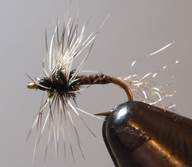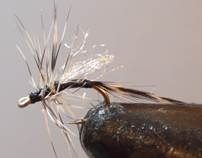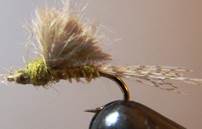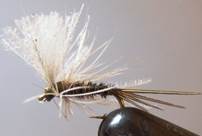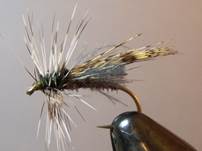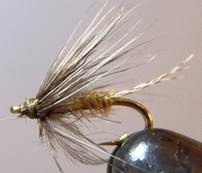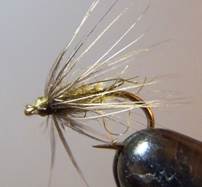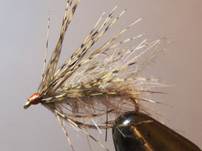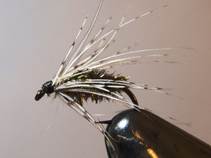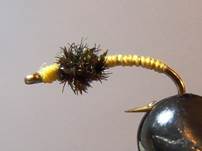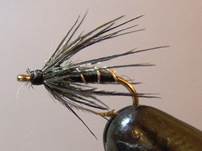LATE & EARLY SEASON FISHING AT DEPUY'S SPRING CREEK (part 7)
| Sysadmin Note |
|---|
| Part 6 can be found here |
SPRING HATCHES
Bugs: Midges can be seen even during winter months as discussed in PART 5. Then spring BWO start to be observed from any time in March. Flies and tactics are very much similar to those applied in the fall (PART 3). In April, as weather gets warmer, caddis can be observed too. Trout rise on each of them with delight. We can expect great dry-fly fishing after long winter. As in the fall, BWO and midge tend to hatch in great numbers on calm overcast days.
Flies: Here is the list of surface types (adults, cripples, and emergers).
Midge (more patterns in PART 5)
|
|
|
Multi Purpose Midge – Master Angler Hook: Dai-Riki 310 size 18, 20, 22 |
Foam Wing Emerger Type 2 Hook: Dai-Riki 270 size 20, 22, 24 |
Coming Out Midge Emerger Hook: Dai-Riki 125 size 20, 22 |
At the beginning, this pattern represents an emerging midge. By trimming tail, it will represent adult midge. By trimming top & bottom hackle fibers, it will imitate low-riding spent midge. All can be done while fishing at the creek! |
I wouldn't apply any floatant on this one. I'd rather let it float with buoyancy of foam as it will imitate suspended midge along surface film (just ready to emerge). |
A great cross-dresser of adult and emerger. Tail of this pattern actually represents a shuck of pupa. Like Multi-Purpose or my own MMM (Part 5), tail can be trimmed at the creek to fish for adult midges. |
BWO (more patterns in PART 3)
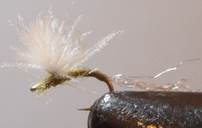 |
|
|
CDC Sparkle Dun Hook: Standard dry or emerger #18, 20, 22 |
Yamamoto's Pheasant Puff Hook: Dai-Riki 310 size 18, 20, 22 |
Yamamoto's Pheasant Tail Mayfly Cripple – CDC Wing Hook: Standard dry size 18, 20, 22 |
Regular Sparkle Dun (or Compara Dun) still works. However CDC wing version has been proven to be more effective. Besides, CDC has more color variations than deer hair and is easy to adjust density of wing. |
A slight twitch of old RS-2. It's also a waste-recycle project at my tying bench. No other materials have such natural dun coloration like fibers from the stem of pheasant feathers. |
Tied with CDC wing, entire silhouette looks lighter than the original synthetic wing. Yet it's still highly visible and floats really well. |
Caddis
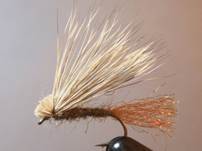 |
|
|
X Caddis Hook: Standard dry size 14 – 20 |
Henry's Fork Caddis Hook: Standard dry size 14 – 20 |
CDC Bubble Back Caddis Hook: Dai-Riki 125 size 14 – 20 |
This simple & classic pattern is still one of go-to caddis flies. Common colors are olive, tan, and black. |
Definitely one of most realistic caddis imitations. Tying procedure is straight forward. Trim or make a v-notch bottom hackle fibers if desired. |
A great emerging imitation to fish the surface film. One can't go wrong with the combination of CDC and partridge. |
Cope with Winds: Only one limiting (and frustrating) factor for dry-fly fishing in spring is the same old SW winds. When wind gales during winter, we can simply cancel fishing or defreeze ourselves in warming huts. In spring it can be frustrating because the air temperature is warm enough to be outside but winds are typically stronger than winter months and blow all the bugs away to Canada. However, as a Livingston guide and resident, let me advise you "stop complaining (whining), we can fish". Let us see this way; we know bugs are plentiful and ready to hatch and trout are willing to take them (after being fed up with eggs and scuds for months). My tactics is soft-hackle swing. I rig up a combination of BWO, midge, and caddis soft-hackles. I first choose riffles. Just try to cast cross-stream, and wind will set your angles automatically. You may need to mend your line up-stream in order to slow down your swinging speed. One of my favorite spots is the tail-end of closed area around Eva's Hut. Often I'm with my little 4 weight rod with tiny soft-hackles. But I'm afraid other anglers might suspect that I would be assaulting spawners by throwing eggs and leeches up-stream. If you readers happen to see me there, I'm not poaching!! Besides riffles, I keep flat sections in mind as next game plans. Winds cause waves at sections where the creek runs flat and smooth on calm days. With newly and temporarily generated water movements, soft-hackles can be swung just below the surface in a manner different from calm days. That really entices trout curiosity.
|
|
|
Flymph – Master Angler Version Hook: Dai-Riki 310 size 18, 20, 22 |
Tom's Simple Soft Hackle – Master Angler Hook: Dai-Riki 125 or 135 size 18, 20, 22 |
Yamamoto's Double Soft-Hackled Caddis Hook: Dai-Riki 280 size 16 and 18 |
This Flymph represents many stages all at once. It can be fished from surface film to certain depth where trout are keying on. Also it can be fished by dead-drift, swing, and twitch. |
Tied in Emerger hook, it will be deadly on the surface. To let it sink where trout are keying on, tie with scud hook (same shape but heavier). |
This is the super-versatile soft-hackle. It can be fished from the surface to any depths. It's also deadly at Yellowstone River. By changing colors and sizes, one can imitate any caddis species. |
|
|
|
Syl's Midge Hook: TMC 102Y size 19 and 21 |
Peacock & Yellow Larva Style Hook: Dai-Riki 280 or 270 size 20, 22, 24 |
Yamamoto's Split Shuck Emerger Hook: Dai-Riki 310 size 18 to 22 |
One can't go wrong with this all-time successful pattern! |
Believe or not, this can be classified as soft-hackle and fished by swinging during midge hatches. |
I have observed many trout keying on midges that were just leaving their pupa shucks at surface film. This pattern imitate a split shuck and coming out insect. |
Satoshi Yamamoto, https://leftyangler.blogspot.com, brought his passion for fly-fishing & fly-tying from Japan to Montana and became the first ever Japanese guide in Livingston, MT. He guides and fish's big rivers like Madison & Yellowstone, spring creeks in Paradise Valley, and various waters in Yellowstone Park. Hence, with his Regal Vise at the bench, his fly tying interests vary from tiny midges to 5-inch streamers and anything in between. Once his ideas are combined he goes out for experiments at those near-by waters. Satoshi submits his innovative patterns to Montana Fly Company (www.montanafly.com).
His own innovative original patterns can be purchased from his fly-shop, https://leftytyer.blogspot.com.
| Sysadmin Note |
|---|
| Part 8 can be found here |

